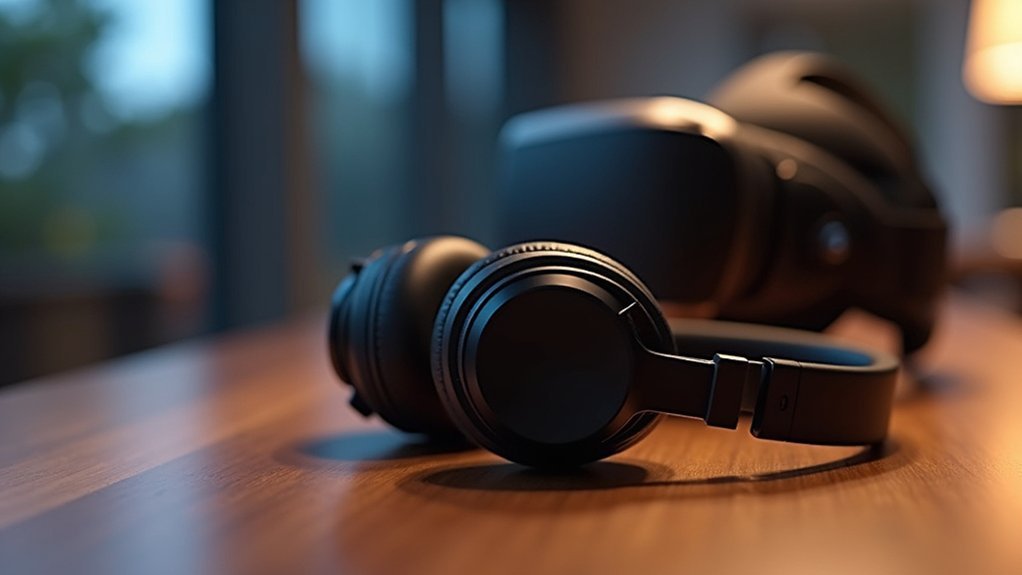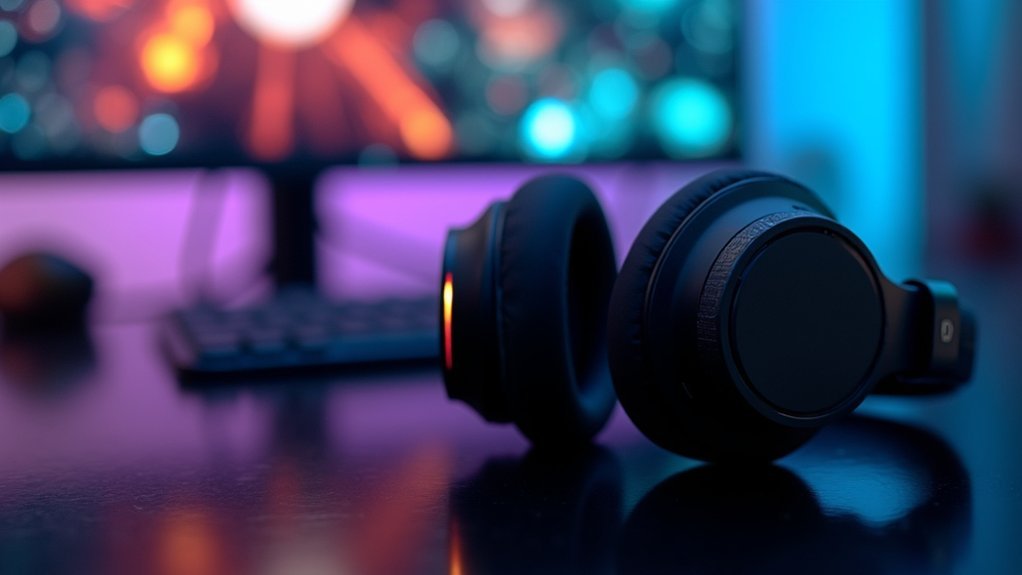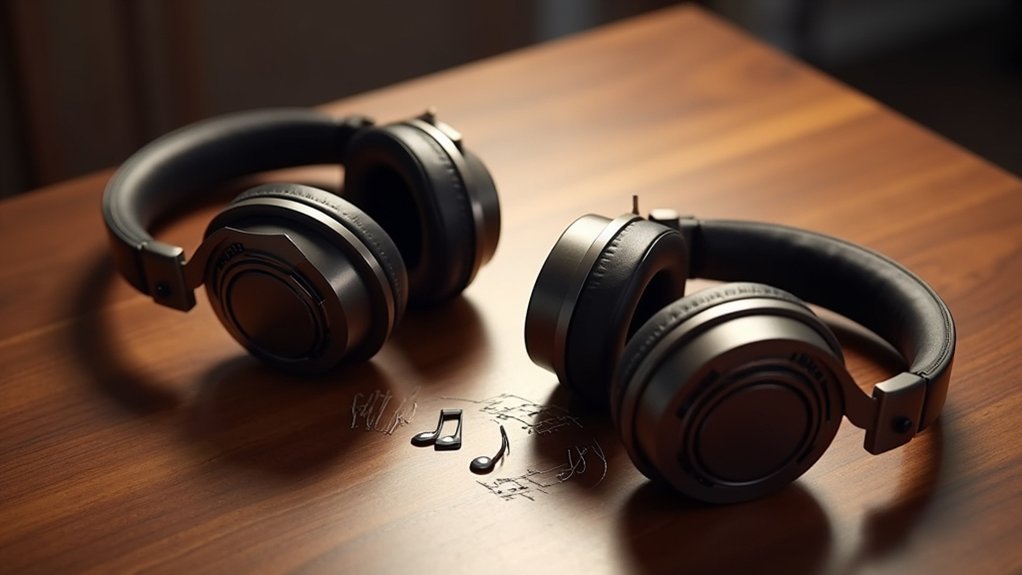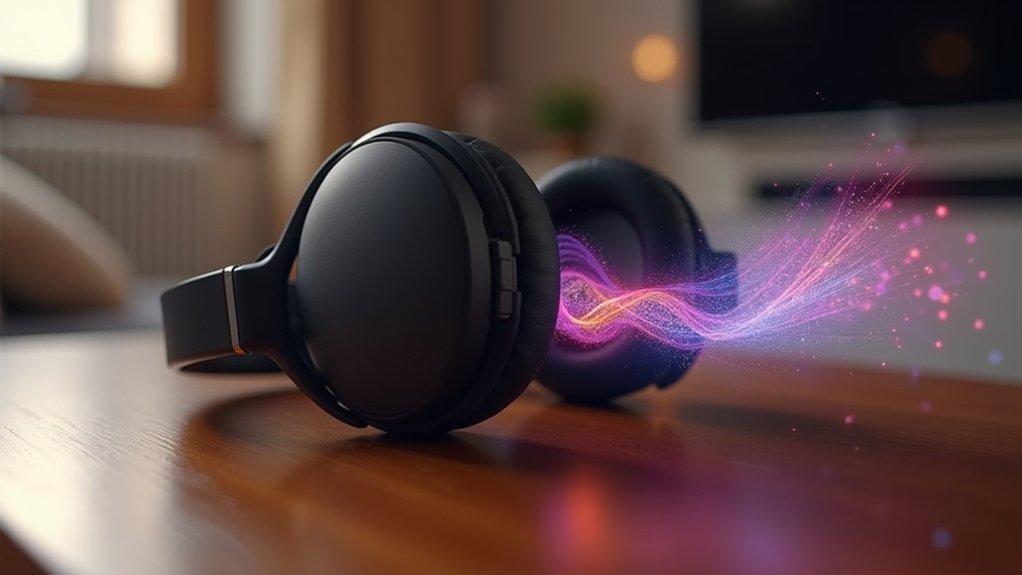You’ll want headphones with planar magnetic drivers like the Audeze Maxwell Wireless, which features Dolby Atmos support for exceptional spatial positioning. The HyperX Cloud Alpha Wireless offers DTS surround sound with an incredible 300-hour battery life, while the SteelSeries Arctis Nova Pro Wireless provides customizable equalizers and active noise cancellation. Look for low latency under 20 milliseconds and Bluetooth 5.3 connectivity to prevent motion sickness during VR sessions. Below you’ll discover detailed comparisons and expert recommendations.
Best Wireless Headphones for VR Spatial Audio Performance

Five standout wireless headphones excel at delivering the precise spatial audio performance that VR gaming demands.
The Audeze Maxwell Wireless leads with planar magnetic drivers and Dolby Atmos support, creating truly immersive sound experiences.
You’ll appreciate the Corsair HS80 RGB Wireless for its spatial audio capabilities that enhance directional awareness in virtual environments.
The SteelSeries Arctis Nova Pro Wireless offers customizable sound through its adjustable equalizer, letting you tailor audio for peak VR performance.
HyperX Cloud Alpha Wireless delivers a realistic audio experience using DTS surround sound technology.
The Razer BlackShark V2 Pro features a high-quality microphone and advanced audio settings for precise positioning.
These best wireless headphones transform your VR sessions with superior spatial accuracy.
Key Features to Look for in 3D Sound Wireless Headphones
When selecting wireless headphones for 3D sound, you’ll want to prioritize advanced audio technologies like Dolby Atmos or DTS:X that create authentic spatial audio experiences.
Prioritize Dolby Atmos and DTS:X technologies when choosing wireless headphones to ensure truly immersive three-dimensional audio experiences.
These formats provide vital audio cues for accurate sound positioning in three-dimensional space. High-quality drivers are essential for superior sound reproduction.
Planar magnetic or larger dynamic drivers deliver the precision needed for immersive sound experiences. You’ll also benefit from adjustable equalizers and spatial audio settings that let you customize audio output for different media types.
Consider these important factors:
- Battery Life – Choose models with at least 20 hours of playtime to avoid interruptions
- Comfortable Fit – Extended listening sessions require ergonomic designs
- Lightweight Design – Reduces fatigue during prolonged 3D sound sessions
Top-Rated Models for Virtual Reality Gaming and Entertainment

Several exceptional wireless headphones models stand out for their ability to deliver premium 3D sound experiences in virtual reality gaming and entertainment.
The Audeze Maxwell Wireless features planar magnetic drivers with Dolby Atmos support, creating exceptional spatial audio capabilities for VR environments.
HyperX Cloud Alpha Wireless provides DTS surround sound and remarkable 300-hour battery life, perfect for extended gaming sessions.
Corsair HS80 RGB Wireless delivers immersive sound experience through its Dolby Atmos support, enhancing your VR adventures.
SteelSeries Arctis Nova Pro Wireless combines superb bass response with active noise cancellation, ensuring uninterrupted virtual reality gaming.
Bang & Olufsen Beoplay Portal offers seamless connectivity and impressive noise cancelling technology, making it ideal for gaming and entertainment scenarios requiring premium audio quality.
Wireless Connectivity and Latency Considerations for VR
While selecting premium wireless headphones matters greatly, understanding how these devices connect to your VR system determines whether you’ll experience seamless immersion or frustrating audio delays.
Wireless connectivity directly impacts your immersive experience, as VR applications demand exceptional precision timing.
Low latency becomes critical when delays exceeding 20 milliseconds cause motion sickness and disorientation. Advanced wireless technology like Bluetooth 5.3 delivers superior audio quality compared to standard connections, while proprietary wireless solutions often provide extended wireless range beyond typical 30-foot limitations.
Consider these essential connectivity features:
- Dual connectivity capabilities for simultaneous device connections
- Sub-20ms latency performance for comfortable extended use
- Reliable wireless range maintaining consistent audio quality throughout your play space
Choose headphones prioritizing these specifications for peak VR performance.
Sound Quality Comparison: Planar Magnetic Vs Traditional Drivers

How dramatically can driver technology transform your wireless headphone experience? Planar magnetic drivers deliver superior audio detail and wider soundstage compared to traditional drivers, considerably enhancing your immersive experience.
While traditional drivers use circular diaphragm movement, planar magnetic technology employs flat diaphragms suspended between magnets, resulting in lower distortion and improved transient response.
You’ll notice planar magnetic drivers provide more natural sound reproduction with better bass response, whereas traditional drivers exhibit variable sound quality depending on design. The frequency response of planar magnetic technology remains more consistent across wider ranges, enabling precise sound positioning that’s essential for 3D audio experiences.
However, planar magnetic headphones require more power and add weight, while traditional drivers offer greater portability and efficient low-power operation for your wireless needs.
Frequently Asked Questions
What Are the Best Headphones for Immersive Music?
You’ll want the Sony WH-1000XM5 for exceptional noise cancellation, Audeze LCD-X for superior audio detail, or Sennheiser HD 800S for precise imaging. Each delivers immersive experiences through different strengths.
Which Headphones Support 3D Audio?
You’ll find 3D audio support in the Audeze Maxwell with Dolby Atmos, Sony WH-1000XM5’s spatial audio, SteelSeries Arctis Nova Pro’s customizable features, PlayStation Pulse Elite’s Tempest tech, and Razer BlackShark V2 Pro’s THX technology.
Why Are Gen Z Ploughing Their Headphones In?
You’re investing heavily in headphones because you demand immersive 3D audio for gaming, streaming, and content creation. You want spatial sound, Dolby Atmos support, and advanced features that’ll enhance your music, movies, and overall digital experiences.
What Headphones Have the Best Spatial Audio?
You’ll find the Audeze Maxwell Wireless delivers exceptional spatial audio with its planar magnetic drivers and Dolby Atmos support, creating precise imaging that outperforms competitors for truly immersive 3D sound experiences.
In Summary
You’ll find that investing in quality wireless headphones transforms your VR experience completely. Whether you’re choosing planar magnetic drivers for audiophile-grade clarity or traditional drivers for balanced performance, you can’t go wrong with low-latency connectivity and proper spatial audio support. Don’t compromise on comfort during extended gaming sessions. You’ve got excellent options available that’ll deliver the immersive 3D soundscape you’re seeking for virtual reality entertainment.





Leave a Reply